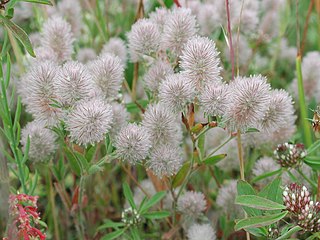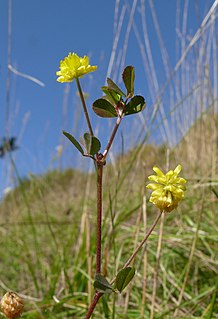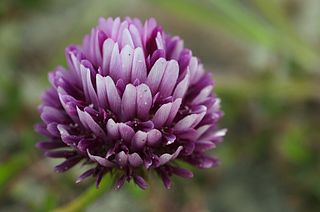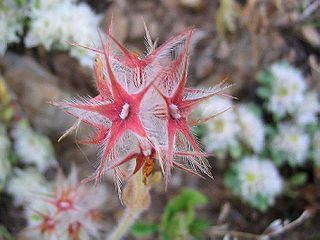
Clover or trefoil are common names for plants of the genus Trifolium, consisting of about 300 species of flowering plants in the legume or pea family Fabaceae originating in Europe. The genus has a cosmopolitan distribution with highest diversity in the temperate Northern Hemisphere, but many species also occur in South America and Africa, including at high altitudes on mountains in the tropics. They are small annual, biennial, or short-lived perennial herbaceous plants, typically growing up to 30 cm tall. The leaves are trifoliate, monofoil, bifoil, cinquefoil, hexafoil, septfoil, etcetera, with stipules adnate to the leaf-stalk, and heads or dense spikes of small red, purple, white, or yellow flowers; the small, few-seeded pods are enclosed in the calyx. Other closely related genera often called clovers include Melilotus and Medicago.

A trefoil is a graphic form composed of the outline of three overlapping rings, used in architecture and Christian symbolism, among other areas. The term is also applied to other symbols with a threefold shape. A similar shape with four rings is called a quatrefoil.

A shamrock is a young sprig, used as a symbol of Ireland. Saint Patrick, Ireland's patron saint, is said to have used it as a metaphor for the Christian Holy Trinity. The name shamrock comes from Irish seamróg, which is the diminutive of the Irish word seamair óg and simply means "young clover".

Forage is a plant material eaten by grazing livestock. Historically, the term forage has meant only plants eaten by the animals directly as pasture, crop residue, or immature cereal crops, but it is also used more loosely to include similar plants cut for fodder and carried to the animals, especially as hay or silage.

Trifolium repens, white clover, is a herbaceous perennial plant in the bean family Fabaceae. It is native to Europe, including the British Isles, and central Asia and is one of the most widely cultivated types of clover. It has been widely introduced worldwide as a forage crop, and is now also common in most grassy areas of North America, Australia and New Zealand. The species includes varieties often classed as small, intermediate and large, according to height, which reflects petiole length. The term 'white clover' is applied to the species in general, 'Dutch clover' is often applied to intermediate varieties, and 'ladino clover' is applied to large varieties.

The four-leaf clover is a rare variation of the common three-leaf clover. According to traditional sayings, such clovers bring good luck, though it is not clear when or how this idea began. The earliest mention of "Fower-leafed or purple grasse" is from 1640 and simply says that it was kept in gardens because it was "good for the purples in children or others". A description from 1869 says that four-leaf clovers were "gathered at night-time during the full moon by sorceresses, who mixed it with vervain and other ingredients, while young girls in search of a token of perfect happiness made quest of the plant by day". The first reference to luck might be from an 11-year-old girl, who wrote in an 1877 letter to St. Nicholas Magazine, "Did the fairies ever whisper in your ear, that a four-leaf clover brought good luck to the finder?"

Trifolium pratense, the red clover, is a herbaceous species of flowering plant in the bean family Fabaceae, native to Europe, Western Asia, and northwest Africa, but planted and naturalized in many other regions.

Trifolium arvense, commonly known as the hare's-foot clover, rabbitfoot clover, stone clover or oldfield clover, is a flowering plant in the bean family Fabaceae. This species of clover is native to most of Europe, excluding the Arctic zone, and western Asia, in plain or mid-mountain habitats up to 1,600 metres (5,200 ft) altitude. It grows in dry sandy soils, both acidic and alkaline, soil with dry-mesic conditions and is typically found at the edge of fields, in wastelands, at the side of roads, on sand dunes, and opportunistically in vineyards and orchards when they are not irrigated.

Trifolium campestre, commonly known as hop trefoil, field clover and low hop clover, is a species of flowering plant native to Europe and western Asia, growing in dry, sandy grassland habitats, fields, woodland margins, roadsides, wastelands and cultivated land. The species name campestre means "of the fields".

Trifolium incarnatum, known as crimson clover or Italian clover, is a species of flowering plant in the family Fabaceae, native to most of Europe. It has been introduced to other areas, including the United States and Japan.

Trifolium wormskioldii is a species of clover. Its common names include cows clover, coast clover, sand clover, seaside clover, springbank clover, and Wormskjold's clover.
Trifolium breweri, which has the common names forest clover and Brewer's clover, is a perennial clover that is native to mixed evergreen forests and coastal coniferous forests in Southern Oregon and California.

Trifolium occidentale, the western clover, is a clover plant belonging to the genus Trifolium in the legume family, Fabaceae. Its flowers are white, similar to white clover, with which it has long been confused. This species lives almost exclusively in sand dunes and sea cliffs on the Atlantic coast of Europe, especially Cornwall and the Channel Islands. The species was first described in 1961 by Dr David E Coombe of Cambridge University.
Hypericum australe is a species of plants in the family Hypericaceae. Individuals can grow to 24 cm tall.
Trifolium lucanicum is a species of plants in the family Fabaceae.

Trifolium scabrum, the rough clover, is a species of annual herb in the family Fabaceae. They have a self-supporting growth form and compound, broad leaves. Individuals can grow to 0.12 m.
Trifolium squarrosum is a species of annual herb in the family Fabaceae. They have a self-supporting growth form and compound, broad leaves.

Trifolium stellatum, the star clover, is a species of annual herb in the family Fabaceae. They have a self-supporting growth form and compound, broad leaves. Flowers are visited by mason bees, Anthocopa, Osmia aurulenta, and Anthophora. Individuals can grow to 0.11 m.

Trifolium suffocatum, the suffocated clover, is a species of annual herb in the family Fabaceae. They have a self-supporting growth form and compound, broad leaves. Individuals can grow to 4.2 cm.

Trifolium tomentosum, the woolly clover, is a species of annual herb in the family Fabaceae. They have a self-supporting growth form and compound, broad leaves. Individuals can grow to 8.9 cm.
















